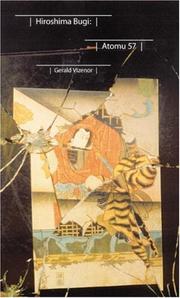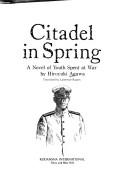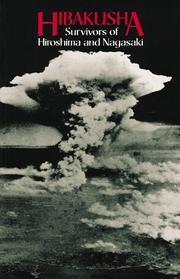| Listing 1 - 9 of 9 |
Sort by
|
Book
ISBN: 0773421041 9780773421042 9780773438156 0773438157 Year: 2010 Publisher: Lewiston, N.Y. Edwin Mellen Press
Abstract | Keywords | Export | Availability | Bookmark
 Loading...
Loading...Choose an application
- Reference Manager
- EndNote
- RefWorks (Direct export to RefWorks)
Crime --- Violence --- Criminal justice, Administration of --- History --- Hiroshima-shi (Japan) --- Poetry. --- Hiroshima --- Hirosima-si (Japan) --- Hiroschima (Japan) --- Khirosima (Japan) --- Hirosjima (Japan) --- Hiroshima (Japan) --- Hiroshimah (Japan) --- Kabe-machi (Japan) --- Asa-chō (Japan) --- Aki-chō (Japan) --- Shiraki-chō (Japan) --- Numata-chō (Hiroshima-ken, Japan) --- Senogawa-chō (Japan) --- Funakoshi-chō (Hiroshima-ken, Japan) --- Hesaka-chō (Japan) --- Itsukaichi-chō (Hiroshima-ken, Japan) --- Nakayama-mura (Hiroshima-ken, Japan) --- Inokuchi-mura (Hiroshima-ken, Japan) --- Crime - Europe - History --- Violence - Europe - History --- Criminal justice, Administration of - Europe - History

ISBN: 0803203470 9780803203471 0803246730 9780803246737 Year: 2003 Publisher: Lincoln : Baltimore, Md. : University of Nebraska Press, Project MUSE,
Abstract | Keywords | Export | Availability | Bookmark
 Loading...
Loading...Choose an application
- Reference Manager
- EndNote
- RefWorks (Direct export to RefWorks)
"Hiroshima Bugi: Atomu 57 is a kabuki novel that begins in the ruins of the Atomic Bomb Dome, a new Rashomon Gate. Ronin Browne, the humane peace contender, is the hafu orphan son of Okichi, a Japanese boogie-woogie dancer, and Nightbreaker, an Anishinaabe from the White Earth Reservation who served as an interpreter for General Douglas MacArthur during the first year of the American occupation in Japan." "Ronin draws on samurai and native traditions to confront the moral burdens and passive notions of nuclear peace celebrated at the peace memorial Museum in Hiroshima. He creates a new calendar that starts with the first use of atomic weapons, Atomu One. Ronin accosts the spirits of the war dead at Yasukuni Jinga. He then marches into the national shrine and shouts to Tojo Hideki and other war criminals to come out and face the spirits of thousands of devoted children who were sacrificed at Hiroshima."--Jacket.
Alienation (Social psychology) --- Japanese --- Indians of North America --- Racially mixed people --- Ethnology --- Hiroshima-shi (Japan) --- Hiroshima --- Hirosima-si (Japan) --- Hiroschima (Japan) --- Khirosima (Japan) --- Hirosjima (Japan) --- Hiroshima (Japan) --- Hiroshimah (Japan) --- Kabe-machi (Japan) --- Asa-chō (Japan) --- Aki-chō (Japan) --- Shiraki-chō (Japan) --- Numata-chō (Hiroshima-ken, Japan) --- Senogawa-chō (Japan) --- Funakoshi-chō (Hiroshima-ken, Japan) --- Hesaka-chō (Japan) --- Itsukaichi-chō (Hiroshima-ken, Japan) --- Nakayama-mura (Hiroshima-ken, Japan) --- Inokuchi-mura (Hiroshima-ken, Japan) --- Multiracial people

ISBN: 0870119605 4770014600 Year: 1990 Publisher: Tokyo Kodansha international
Abstract | Keywords | Export | Availability | Bookmark
 Loading...
Loading...Choose an application
- Reference Manager
- EndNote
- RefWorks (Direct export to RefWorks)
J5933 --- Japan: Literature -- modern fiction and prose by individual authors (1868- ) --- Hirosjima --- World War, 1939-1945 --- Wereldoorlog II --- verhalen --- Fiction. --- Hiroshima-shi (Japan) --- History --- verhalen. --- Fiction --- Hiroshima --- Hirosima-si (Japan) --- Hiroschima (Japan) --- Khirosima (Japan) --- Hirosjima (Japan) --- Hiroshima (Japan) --- Hiroshimah (Japan) --- Kabe-machi (Japan) --- Asa-chō (Japan) --- Aki-chō (Japan) --- Shiraki-chō (Japan) --- Numata-chō (Hiroshima-ken, Japan) --- Senogawa-chō (Japan) --- Funakoshi-chō (Hiroshima-ken, Japan) --- Hesaka-chō (Japan) --- Itsukaichi-chō (Hiroshima-ken, Japan) --- Nakayama-mura (Hiroshima-ken, Japan) --- Inokuchi-mura (Hiroshima-ken, Japan) --- Verhalen.

ISBN: 433301204X Year: 1986 Publisher: Tokyo Kosei Publishing
Abstract | Keywords | Export | Availability | Bookmark
 Loading...
Loading...Choose an application
- Reference Manager
- EndNote
- RefWorks (Direct export to RefWorks)
First hand accounts of the first victims of nuclear weapons.
History of Asia --- anno 1940-1949 --- Hiroshima --- Nagasaki --- Atomic bomb victims --- 838.1 Ecologie --- 844.5 Gezondheid --- 872 Massavernietigingswapens --- 883.2 Oost-Azië --- A-bomb victims --- Hibakusha --- Victims of atomic bombings --- War victims --- Biography --- Hiroshima-shi (Japan) --- Nagasaki-shi (Japan) --- Nagasaki (Japan) --- Hirosima-si (Japan) --- Hiroschima (Japan) --- Khirosima (Japan) --- Hirosjima (Japan) --- Hiroshima (Japan) --- Hiroshimah (Japan) --- Kabe-machi (Japan) --- Asa-chō (Japan) --- Aki-chō (Japan) --- Shiraki-chō (Japan) --- Numata-chō (Hiroshima-ken, Japan) --- Senogawa-chō (Japan) --- Funakoshi-chō (Hiroshima-ken, Japan) --- Hesaka-chō (Japan) --- Itsukaichi-chō (Hiroshima-ken, Japan) --- Nakayama-mura (Hiroshima-ken, Japan) --- Inokuchi-mura (Hiroshima-ken, Japan) --- History --- Personal narratives.
Book
ISBN: 1108892094 110888055X 1108871879 1108835279 Year: 2021 Publisher: Cambridge : Cambridge University Press,
Abstract | Keywords | Export | Availability | Bookmark
 Loading...
Loading...Choose an application
- Reference Manager
- EndNote
- RefWorks (Direct export to RefWorks)
American Survivors is a fresh and moving historical account of U.S. survivors of the Hiroshima and Nagasaki atomic bombings, breaking new ground not only in the study of World War II but also in the public understanding of nuclear weaponry. A truly trans-Pacific history, American Survivors challenges the dualistic distinction between Americans-as-victors and Japanese-as-victims often assumed by scholars of the nuclear war. Using more than 130 oral histories of Japanese American and Korean American survivors, their family members, community activists, and physicians - most of which appear here for the first time - Naoko Wake reveals a cross-national history of war, illness, immigration, gender, family, and community from intimately personal perspectives. American Survivors brings to light the history of Hiroshima and Nagasaki that connects, as much as separates, people across time and national boundaries.
World War, 1939-1945 --- Americans --- Atomic bomb victims --- Japanese Americans. --- Hiroshima-shi (Japan) --- Nagasaki-shi (Japan) --- History --- Personal narratives, American. --- A-bomb victims --- Hibakusha --- Victims of atomic bombings --- War victims --- Nagasaki (Japan) --- Hiroshima --- Hirosima-si (Japan) --- Hiroschima (Japan) --- Khirosima (Japan) --- Hirosjima (Japan) --- Hiroshima (Japan) --- Hiroshimah (Japan) --- Kabe-machi (Japan) --- Asa-chō (Japan) --- Aki-chō (Japan) --- Shiraki-chō (Japan) --- Numata-chō (Hiroshima-ken, Japan) --- Senogawa-chō (Japan) --- Funakoshi-chō (Hiroshima-ken, Japan) --- Hesaka-chō (Japan) --- Itsukaichi-chō (Hiroshima-ken, Japan) --- Nakayama-mura (Hiroshima-ken, Japan) --- Inokuchi-mura (Hiroshima-ken, Japan)
Book
ISBN: 128282063X 9786612820632 1442207493 9781442207493 9781442207479 1442207477 Year: 2010 Publisher: New York Rowman & Littlefield Publishers
Abstract | Keywords | Export | Availability | Bookmark
 Loading...
Loading...Choose an application
- Reference Manager
- EndNote
- RefWorks (Direct export to RefWorks)
This compelling autobiography tells the life story of famed manga artist Nakazawa Keiji. Born in Hiroshima in 1939, Nakazawa was six years old when on August 6, 1945, the United States dropped the atomic bomb. His gritty and stunning account of the horrific aftermath is powerfully told through the eyes of a child who lost most of his family and neighbors. The narrative continues through the brutally difficult years immediately after the war, his art apprenticeship in Tokyo, his pioneering ""atomic-bomb"" manga, and the creation of Bar
Cartoonists --- Comic books, strips, etc. --- Atomic bomb victims --- Comic strips --- Comics --- Funnies --- Manga (Comic books, strips, etc.) --- Manhua (Comic books, strips, etc.) --- Manhwa (Comic books, strips, etc.) --- Serial picture books --- Caricatures and cartoons --- Wit and humor, Pictorial --- History. --- Nakazawa, Keiji. --- Nakazawa, Keiji --- 中沢啓治 --- 中沢啓治. --- Childhood and youth. --- Family. --- Hiroshima-shi (Japan) --- Japan --- Hiroshima --- Hirosima-si (Japan) --- Hiroschima (Japan) --- Khirosima (Japan) --- Hirosjima (Japan) --- Hiroshima (Japan) --- Hiroshimah (Japan) --- Kabe-machi (Japan) --- Asa-chō (Japan) --- Aki-chō (Japan) --- Shiraki-chō (Japan) --- Numata-chō (Hiroshima-ken, Japan) --- Senogawa-chō (Japan) --- Funakoshi-chō (Hiroshima-ken, Japan) --- Hesaka-chō (Japan) --- Itsukaichi-chō (Hiroshima-ken, Japan) --- Nakayama-mura (Hiroshima-ken, Japan) --- Inokuchi-mura (Hiroshima-ken, Japan) --- History --- Manhua (Comic books) --- Manhwa (Comic books) --- Drawing --- Literature --- Graphic artists --- beeldverhalen
Book
ISBN: 2911716361 9782911716362 Year: 2001 Publisher: Calais Musée des Beaux-Arts et de la Dentelle de Calais
Abstract | Keywords | Export | Availability | Bookmark
 Loading...
Loading...Choose an application
- Reference Manager
- EndNote
- RefWorks (Direct export to RefWorks)
7.07 --- Beeldende kunst ; 2de helft 20ste eeuw ; Marie-Ange Guilleminot --- Vrouwelijke kunstenaars --- Guilleminot, Marie-Ange °1960 (°Saint-Germain-en-Laye, Frankrijk) --- Kunstenaars met verschillende disciplines, niet traditioneel klasseerbare, conceptuele kunstenaars A - Z --- Guilleminot, Marie-Ange --- Bombardment of Hiroshima-shi (Japan : 1945) --- Hiroshima-shi (Japan) --- Hiroshima --- Hirosima-si (Japan) --- Hiroschima (Japan) --- Khirosima (Japan) --- Hirosjima (Japan) --- Hiroshima (Japan) --- Hiroshimah (Japan) --- Kabe-machi (Japan) --- Asa-chō (Japan) --- Aki-chō (Japan) --- Shiraki-chō (Japan) --- Numata-chō (Hiroshima-ken, Japan) --- Senogawa-chō (Japan) --- Funakoshi-chō (Hiroshima-ken, Japan) --- Hesaka-chō (Japan) --- Itsukaichi-chō (Hiroshima-ken, Japan) --- Nakayama-mura (Hiroshima-ken, Japan) --- Inokuchi-mura (Hiroshima-ken, Japan) --- History --- Exhibitions --- Art styles --- Iconography --- Art --- Sculpture --- installations [visual works] --- happenings --- art [fine art] --- wars --- performance art --- textile materials --- sculpting --- anno 1950-1959 --- anno 1960-1969 --- anno 1970-1979 --- anno 1900-1999 --- anno 2000-2099 --- France --- art [discipline]
Book
ISBN: 1316143643 131614366X 1316144089 1316144054 1316143716 1107416590 1316144062 1316144100 1316144070 1107775442 1107071275 1322177406 Year: 2014 Publisher: Cambridge : Cambridge University Press,
Abstract | Keywords | Export | Availability | Bookmark
 Loading...
Loading...Choose an application
- Reference Manager
- EndNote
- RefWorks (Direct export to RefWorks)
In 1962, a Hiroshima peace delegation and an Auschwitz survivor's organization exchanged relics and testimonies, including the bones and ashes of Auschwitz victims. This symbolic encounter, in which the dead were literally conscripted in the service of the politics of the living, serves as a cornerstone of this volume, capturing how memory was utilized to rebuild and redefine a shattered world. This is a powerful study of the contentious history of remembrance and the commemoration of the atomic bomb in Hiroshima in the context of the global development of Holocaust and World War II memory. Emphasizing the importance of nuclear issues in the 1950s and 1960s, Zwigenberg traces the rise of global commemoration culture through the reconstruction of Hiroshima as a 'City of Bright Peace', memorials and museums, global tourism, developments in psychiatry, and the emergence of the figure of the survivor-witness and its consequences for global memory practices.
Collective memory --- Atomic bomb victims --- Memorials --- Peace --- Holocaust, Jewish (1939-1945) --- War victims --- Collective remembrance --- Common memory --- Cultural memory --- Emblematic memory --- Historical memory --- National memory --- Public memory --- Social memory --- Memory --- Social psychology --- Group identity --- National characteristics --- Victims of war --- Victims --- Coexistence, Peaceful --- Peaceful coexistence --- International relations --- Disarmament --- Peace-building --- Security, International --- Commemorations --- Historic sites --- Memorialization --- Monuments --- Political aspects --- Historiography. --- Mental health. --- Hiroshima-shi (Japan) --- Hiroshima --- Hirosima-si (Japan) --- Hiroschima (Japan) --- Khirosima (Japan) --- Hirosjima (Japan) --- Hiroshima (Japan) --- Hiroshimah (Japan) --- Kabe-machi (Japan) --- Asa-chō (Japan) --- Aki-chō (Japan) --- Shiraki-chō (Japan) --- Numata-chō (Hiroshima-ken, Japan) --- Senogawa-chō (Japan) --- Funakoshi-chō (Hiroshima-ken, Japan) --- Hesaka-chō (Japan) --- Itsukaichi-chō (Hiroshima-ken, Japan) --- Nakayama-mura (Hiroshima-ken, Japan) --- Inokuchi-mura (Hiroshima-ken, Japan) --- History --- Moral and ethical aspects.
Book
ISBN: 9780521514194 9780511977336 9780521735360 9781139077279 1139077279 9781139079556 1139079557 0511977336 0521514193 052173536X 1107215676 1139062840 1283110830 9786613110831 1139075012 1139069241 1139081837 9781107215672 9781139062848 9781283110839 6613110833 9781139075015 9781139069243 9781139081832 Year: 2011 Publisher: Cambridge New York Cambridge University Press
Abstract | Keywords | Export | Availability | Bookmark
 Loading...
Loading...Choose an application
- Reference Manager
- EndNote
- RefWorks (Direct export to RefWorks)
This book explores the American use of atomic bombs and the role these weapons played in the defeat of the Japanese Empire in World War II. It focuses on President Harry S. Truman's decision-making regarding this most controversial of all his decisions. The book relies on notable archival research and the best and most recent scholarship on the subject to fashion an incisive overview that is fair and forceful in its judgments. This study addresses a subject that has been much debated among historians and it confronts head-on the highly disputed claim that the Truman administration practised 'atomic diplomacy'. The book goes beyond its central historical analysis to ask whether it was morally right for the United States to use these terrible weapons against Hiroshima and Nagasaki. It also provides a balanced evaluation of the relationship between atomic weapons and the origins of the Cold War.
Atomic bomb --- A-bomb --- Atom bomb --- Bombs --- Nuclear weapons --- History. --- Moral and ethical aspects. --- Truman, Harry S., --- Truman, Harry, --- Trumėn, G., --- Dulumen, --- Trouman, Charry S., --- טרומאן, הארי ס., --- Truman, H. --- Military leadership. --- Hiroshima-shi (Japan) --- Nagasaki-shi (Japan) --- United States --- ABŞ --- ABSh --- Ameerika Ühendriigid --- America (Republic) --- Amerika Birlăshmish Shtatlary --- Amerika Birlăşmi Ştatları --- Amerika Birlăşmiş Ştatları --- Amerika ka Kelenyalen Jamanaw --- Amerika Qūrama Shtattary --- Amerika Qŭshma Shtatlari --- Amerika Qushma Shtattary --- Amerika (Republic) --- Amerikai Egyesült Államok --- Amerikanʹ Veĭtʹsėndi︠a︡vks Shtattnė --- Amerikări Pĕrleshu̇llĕ Shtatsem --- Amerikas Forenede Stater --- Amerikayi Miatsʻyal Nahangner --- Ameriketako Estatu Batuak --- Amirika Carékat --- AQSh --- Ar. ha-B. --- Arhab --- Artsot ha-Berit --- Artzois Ha'bris --- Bí-kok --- Ē.P.A. --- EE.UU. --- Egyesült Államok --- ĒPA --- Estados Unidos --- Estados Unidos da América do Norte --- Estados Unidos de América --- Estaos Xuníos --- Estaos Xuníos d'América --- Estatos Unitos --- Estatos Unitos d'America --- Estats Units d'Amèrica --- Ètats-Unis d'Amèrica --- États-Unis d'Amérique --- Fareyniḳṭe Shṭaṭn --- Feriene Steaten --- Feriene Steaten fan Amearika --- Forente stater --- FS --- Hēnomenai Politeiai Amerikēs --- Hēnōmenes Politeies tēs Amerikēs --- Hiwsisayin Amerikayi Miatsʻeal Tērutʻiwnkʻ --- Istadus Unidus --- Jungtinės Amerikos valstybės --- Mei guo --- Mei-kuo --- Meiguo --- Mî-koet --- Miatsʻyal Nahangner --- Miguk --- Na Stàitean Aonaichte --- NSA --- S.U.A. --- SAD --- Saharat ʻAmērikā --- SASht --- Severo-Amerikanskie Shtaty --- Severo-Amerikanskie Soedinennye Shtaty --- Si︠e︡vero-Amerikanskīe Soedinennye Shtaty --- Sjedinjene Američke Države --- Soedinennye Shtaty Ameriki --- Soedinennye Shtaty Severnoĭ Ameriki --- Soedinennye Shtaty Si︠e︡vernoĭ Ameriki --- Spojené obce severoamerické --- Spojené staty americké --- SShA --- Stadoù-Unanet Amerika --- Stáit Aontaithe Mheiriceá --- Stany Zjednoczone --- Stati Uniti --- Stati Uniti d'America --- Stâts Unîts --- Stâts Unîts di Americhe --- Steatyn Unnaneysit --- Steatyn Unnaneysit America --- SUA (Stati Uniti d'America) --- Sŭedineni amerikanski shtati --- Sŭedinenite shtati --- Tetã peteĩ reko Amérikagua --- U.S. --- U.S.A. --- United States of America --- Unol Daleithiau --- Unol Daleithiau America --- Unuiĝintaj Ŝtatoj de Ameriko --- US --- USA --- Usono --- Vaeinigte Staatn --- Vaeinigte Staatn vo Amerika --- Vereinigte Staaten --- Vereinigte Staaten von Amerika --- Verenigde State van Amerika --- Verenigde Staten --- VS --- VSA --- Wááshindoon Bikéyah Ałhidadiidzooígíí --- Wilāyāt al-Muttaḥidah --- Wilāyāt al-Muttaḥidah al-Amirīkīyah --- Wilāyāt al-Muttaḥidah al-Amrīkīyah --- Yhdysvallat --- Yunaeted Stet --- Yunaeted Stet blong Amerika --- ZDA --- Združene države Amerike --- Zʹi︠e︡dnani Derz︠h︡avy Ameryky --- Zjadnośone staty Ameriki --- Zluchanyi︠a︡ Shtaty Ameryki --- Zlucheni Derz︠h︡avy --- ZSA --- Η.Π.Α. --- Ηνωμένες Πολιτείες της Αμερικής --- Америка (Republic) --- Американь Вейтьсэндявкс Штаттнэ --- Америкӑри Пӗрлешӳллӗ Штатсем --- САЩ --- Съединените щати --- Злучаныя Штаты Амерыкі --- ولايات المتحدة --- ولايات المتّحدة الأمريكيّة --- ولايات المتحدة الامريكية --- 미국 --- Nagasaki (Japan) --- Hiroshima --- Hirosima-si (Japan) --- Hiroschima (Japan) --- Khirosima (Japan) --- Hirosjima (Japan) --- Hiroshima (Japan) --- Hiroshimah (Japan) --- Kabe-machi (Japan) --- Asa-chō (Japan) --- Aki-chō (Japan) --- Shiraki-chō (Japan) --- Numata-chō (Hiroshima-ken, Japan) --- Senogawa-chō (Japan) --- Funakoshi-chō (Hiroshima-ken, Japan) --- Hesaka-chō (Japan) --- Itsukaichi-chō (Hiroshima-ken, Japan) --- Nakayama-mura (Hiroshima-ken, Japan) --- Inokuchi-mura (Hiroshima-ken, Japan) --- History --- Military policy --- Decision making. --- États-Unis --- É.-U. --- ÉU --- Arts and Humanities --- Truman, Harry --- Trumėn, G. --- Dulumen --- Trouman, Charry S.
| Listing 1 - 9 of 9 |
Sort by
|

 Search
Search Feedback
Feedback About UniCat
About UniCat  Help
Help News
News